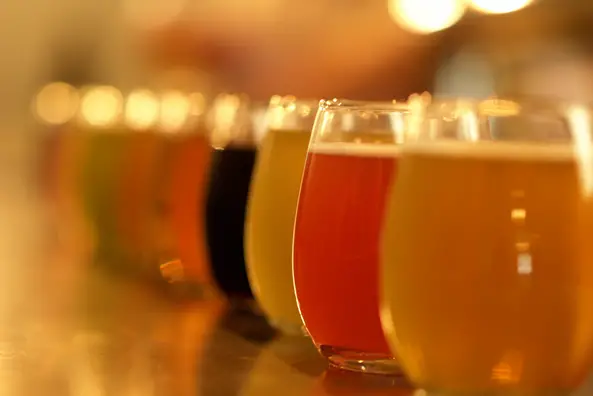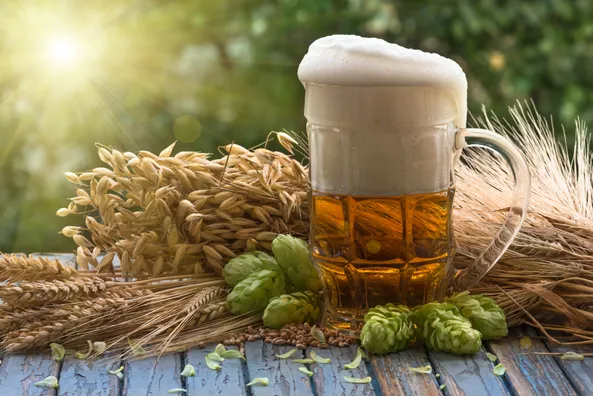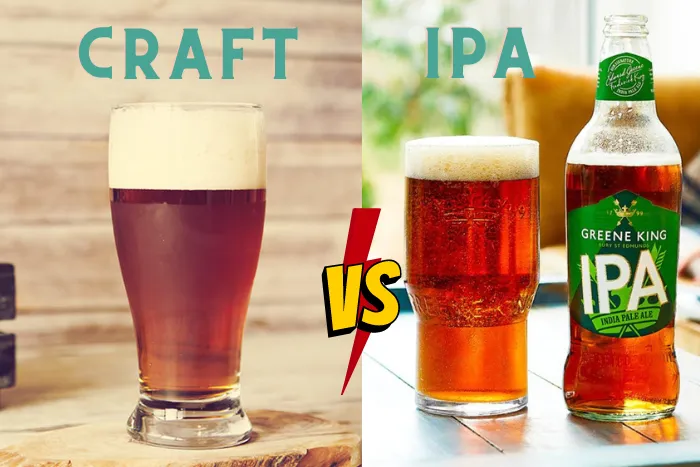The craft beer vs. IPA debate has been around for a long time. Both types of beers offer unique flavors and brewing styles, but which is better?
This blog post covers craft beer and IPA history, ingredients, fermentation methods, and popular brands to help you choose. We cover everything about these two classic drinks, from flavor to mouthfeel to color and alcohol content.
So let’s dive deep into the world of craft beer vs. IPA.
Table of Contents:
- Origins of Craft Beer and IPA Beers
- Ingredients Used in Craft Beer and IPA Beers
- Fermentation and Brewing Process for Craft Beer and IPA Beers
- Popular Brands to Try for Both Types of Beers
- FAQs in Relation to Craft Beer vs Ipa
- Conclusion
Origins of Craft Beers

Craft beer began in religious sanctuaries for spiritual reasons. It now includes lagers, stouts, and everything in between. Craft beer gained popularity in the US in the late 1970s and early 1980s as brewers experimented with new recipes.
There are now thousands of craft breweries all over the world. These breweries make a wide range of unique beers you can buy in stores or local taprooms.
Origins of IPA Beers
IPAs have recently become popular, but they’ve been around for a while, almost as long as craft beer. British brewers created IPAs (India Pale Ales) to avoid spoilage from bacteria during shipping to India. To do this, they added more hops, which gave the beer more flavor and kept it from going bad by stopping bacteria from growing. IPAs range from English-style ales to American versions with intense hop flavors and aromas.
Depending on the style, some regions prefer certain grains, while others prefer different hops or yeast strains. German-style lagers are malt-forward, while Belgian ales use spicier yeast strains like saison or witbier for a unique flavor profile.
Pale ales and IPAs use more neutral ale yeasts. German brewers use decoction mashing, while British brewers use step mashing, which can also affect beer flavor.
Craft and IPA beers have come a long way from their simple beginnings to the more complex blends we enjoy today. Next, let’s explore the components utilized to make these tasty libations.
Ingredients Used in Craft Beer and IPA Beers

Craft beer production typically involves the utilization of barley malt, hops, yeast, and water. Malted barley is the most important ingredient as it provides sugar for fermentation. Hops provide bitterness and flavor to the beer while also acting as a preservative.
Yeast converts the sugars from the malt into alcohol during fermentation. Craft beer is 95% water, which dissolves other ingredients and affects taste. Wheat, oats, and rye can improve porters, stouts, and IPAs (India Pale Ales).
Common Ingredients Used in IPA Brewing:
Hops give India Pale Ales their bitter taste and aroma. IPAs have a lighter base malt than other craft beers, so more hop flavors can come through without being overpowering. Cascade, Centennial, Amarillo, and Citra hops produce citrusy, piney, and resinous aromas.
Some brewers will add adjuncts, such as honey or fruit juices, for extra sweetness or flavor complexity. Due to its intense hoppiness, IPA beer rarely needs these.
Porters, stouts, and IPAs may use wheat, oats, or rye to add complexity and character. Some brewers may add adjuncts such as honey or fruit juices for extra sweetness or flavor complexity.
These are only needed occasionally when making either beer style due to their unique characteristics before any additions, but they can add an interesting twist.
Fermentation for Craft Beer and IPA Beers
The fermentation process for both craft beer and IPA beers is essentially the same. The yeast type is the key distinction between craft beer and IPAs; ale for the former, lager or champagne for the latter. For craft beer, brewers typically use a strain of ale yeast, while IPAs are brewed with lager or champagne yeasts.
During fermentation, sugars from grains are converted into alcohol and carbon dioxide by the yeast. The time for the sugar-alcohol transformation may be different depending on factors like the brew’s instructions and its temperature regulation throughout fermentation.
Brewing Process for Craft Beer and IPA Beers
The brewing process for each type of beer varies slightly as well. Craft beers necessitate a longer boil than IPAs to draw out the hop oils and tastes that grant them their distinct taste, due to having a more intense flavor.
On the other hand, IPAs require less boiling time since their flavor profile is lighter and more subtle than that of a craft beer. Moreover, to impart certain tastes into the beer, some brewers may incorporate extra components such as fruits or spices at various stages during brewing.
The fermentation and brewing processes for craft beer and IPA beers can be quite complex, but with the right knowledge they can both produce delicious results. Moving on to popular brands to try for each type of beer, let’s explore some of the top choices available in today’s market.
Popular Craft and IPA Beer Brands
Recently, craft beer and IPA styles of brews have seen a surge in demand. For those just entering the craft beer or IPA world, there are many choices regarding flavor profiles, colors, alcohol content, and IBU levels. Lucky for us, many great options in both categories have different flavors, colors, alcohol levels, IBU levels, and more.
When it comes to craft beer brands, one of the most popular is Sierra Nevada Pale Ale. This pale ale has a citrusy hop aroma with notes of pine and tropical fruit flavors. At 5.6% ABV, Sierra Nevada Pale Ale is a light yet flavorful beer that appeals to both casual and experienced drinkers alike.
Bell’s Two Hearted Ale is a renowned American-style India Pale Ale, featuring fragrant aromas and grapefruit tones balanced by malty hints with touches of caramel on the aftertaste.
FAQs in Relation to Craft Beer vs Ipa
What is the difference between a craft beer and an IPA?
Craft beer is known for its unique flavors and higher alcohol content. It is made in small batches using traditional methods. It typically features unique ingredients and flavors and has a higher alcohol content than regular beers.
IPA stands for India Pale Ale, a specific craft beer style characterized by its hoppy flavor profile, high bitterness level, and strong aroma. IPAs tend to have higher levels of alcohol than other styles of craft beers, as well as more intense hop characteristics.
Is IPA considered a craft beer?
Yes, IPA is considered a craft beer. Small-scale, independent breweries often craft beers with unusual ingredients and flavors. India Pale Ales (IPAs) fit this description because they usually have more hops than other types of beer, which gives them stronger flavors and aromas.
They also tend to be made with more specialty grains or adjuncts than traditional lagers or ales, distinguishing them from mass-produced commercial beers.
What percent of craft beer is IPA?
Approximately 25–30% of craft beer is IPA. Craft beer drinkers have been drinking more IPAs, leading to IPAs getting a bigger share of the craft beer market. IPAs are a type of ale with an intense hop character, often with citrus or tropical fruit flavors and aromas.
Brewers are becoming more daring with their hop and brewing choices, which means there are more and more IPAs with unique flavors. Due to their growing popularity, IPAs have become a major player in the craft beer industry.
What are the 3 major classifications of beer?
The three major classifications of beer are ales, lagers, and hybrids. Ales are made with yeast that ferments at higher temperatures than lagers. They also have fuller bodies and more alcohol than lagers.
Lagers use yeast that ferments at the bottom at cooler temperatures to produce a crisper flavor and less bitterness. Hybrids offer an eclectic blend of ale and lager brewing techniques, leading to diverse beer characteristics such as hue, flavor, scent, body consistency, ABV (alcohol by volume), etc.
Conclusion
In conclusion, craft beer and IPA beers are different kinds of brews with different tastes, colors, levels of alcohol, IBUs, and health benefits. Knowing the key differences between craft beer and IPA beers can help you make a well-informed decision when choosing your preferred beverage. With so many popular brands available for craft beer vs. ipa beers today, ranging from local breweries to international imports – there’s something out there for everyone.
Discover the best craft beer and IPA reviews, top-of-the-line brewing equipment, subscription services, and homebrewing tips. Join us today to become a part of the thriving world of craft beers!
Also See: A Comprehensive Review of the Homecraft Mini Kegerator
